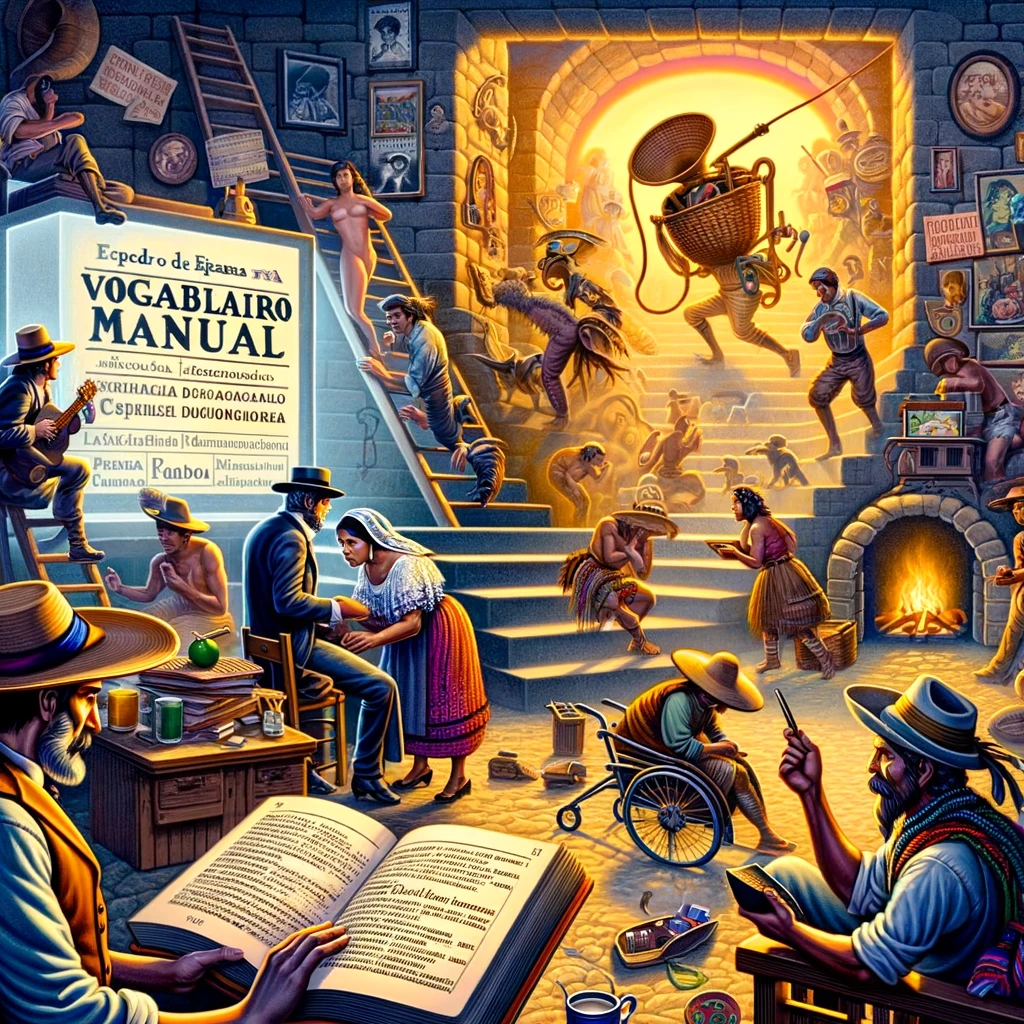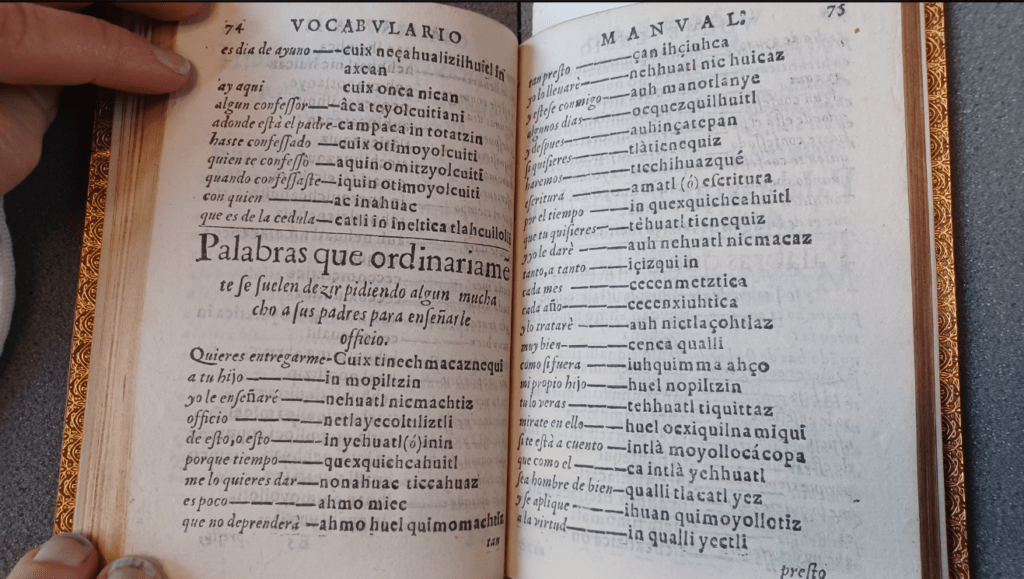In the vast tapestry of history, the threads of individual lives often weave together in ways that official records can hardly capture. The colonial period in Mexico, a time of profound transformation and tumultuous relationships, offers a rich backdrop against which countless personal stories unfolded. Drawing from the intriguing insights provided by Pedro de Arenas’ “Vocabulario Manual,” we embark on a journey to explore the nuanced interactions between the Nahuas and the Spaniards—a tale of communication, culture, and the complexities of colonial life.
Pedro de Arenas’ phrasebook, a unique window into the daily lives of Nahuas and Spaniards, serves as a beacon, guiding us through the intricacies of their everyday encounters. This reflection delves into the symbolism of these interactions, unearthing the layers of meaning beneath the surface of language exchange and cultural adaptation. By examining the subtleties captured in the phrasebook, we can begin to understand the depth of the connections formed in the shadow of colonialism, where language served as both a bridge and a barrier.
Bridging Worlds: The Vocabulario Manual as a Cultural Compass
In the heart of colonial Mexico, amidst the upheaval of conquest and the forging of a new world order, there emerged a quiet testament to the human capacity for adaptation and understanding—the Vocabulario Manual by Pedro de Arenas. This Nahuatl phrasebook, crafted for Spaniards, was more than a mere tool for communication; it was a cultural compass, guiding its users through the complex landscape of Nahua society.

The existence of such a manual illuminates the frequency and necessity of interactions between Nahuas and Spaniards who could not speak Nahuatl. It reflects a reality where the burden of communication did not rest solely on the indigenous people but was shared, recognizing the importance of mutual understanding in everyday transactions. The manual’s repeated reprints, spanning over three centuries including periods after Mexican independence, underscore its enduring relevance, painting a picture of a society in which Nahuas and Spaniards remained inextricably linked, not just through the grand narratives of conquest and colonization, but through the myriad threads of daily life.
Imagine the scene: a Spanish merchant, phrasebook in hand, carefully articulating Nahuatl words to a Nahua artisan, their transaction bridging worlds. Or a Spanish priest, seeking to offer comfort or spiritual guidance to his Nahua parishioners, turning to the manual to find the right words to speak to their hearts. These moments of connection, facilitated by the Vocabulario Manual, highlight the common humanity that can be found even in the midst of societal upheaval.
The person behind this manual, Pedro de Arenas, remains largely a mystery, described only as a “romancista”—an individual without formal education in Latin, likely a Spaniard immersed in trade. Yet, through this phrasebook, Arenas contributed to a legacy of intercultural exchange that challenges our perceptions of colonial dynamics. The manual’s sections, covering a wide range of everyday interactions, from trade and negotiation to personal care and social etiquette, reveal the depth of the social fabric that connected Nahuas and Spaniards.
One cannot help but feel a sense of compassion for these individuals, navigating the challenges of a rapidly changing world. The Vocabulario Manual serves as a poignant reminder of the potential for empathy and understanding, even in times of great divide. It stands as a symbol of the shared human experience, a bridge over the chasm of cultural differences, and a beacon of hope for finding common ground in the most unlikely places.
Whispers of Power and Resistance: The Undercurrents of Colonial Exchange
The interactions depicted in the Vocabulario Manual, while often mundane in nature, were imbued with the undercurrents of power and resistance that characterized the colonial era. This nuanced landscape of colonial exchange was not merely about the transfer of goods or information but was deeply entangled with the dynamics of dominance and resilience.

Through the lens of the manual, we see the colonial world not just as a stage for the exertion of Spanish authority but also as a space where Nahuas exerted agency, subtly negotiating their positions within the imposed colonial structure. The manual’s detailed sections on everyday communicative events—bartering, selling, giving orders—while ostensibly practical, also hint at the everyday resistances and accommodations made by Nahuas in the face of colonial demands.
Particularly revealing are the sections guiding Spaniards on how to request a Nahua child for rearing, ostensibly to teach them a trade. This practice, seemingly benign in its intent to educate, uncovers a layer of colonial strategy aimed at cultural assimilation and control. The phrasebook anticipates the parents’ reluctance, suggesting a narrative where persuasion and negotiation were tools wielded by Spaniards to further entrench their presence and influence within Nahua communities. Yet, the silence of the Nahuas’ responses in the manual speaks volumes, hinting at the complex emotions and resistance that must have pulsed beneath the surface of such interactions.
In these moments, the Vocabulario Manual serves not only as a guide to language but as a mirror reflecting the broader socio-political dynamics at play. It offers glimpses into the lives of Nahuas who navigated the colonial world with resilience, adapting to its challenges while maintaining a sense of identity and agency. This delicate dance of power and resistance is a testament to the strength of the Nahua people, who, despite the overwhelming force of colonial imposition, found ways to assert their humanity and preserve their culture.
The compassion evoked by these narratives is profound. It calls us to reflect on the resilience of the human spirit in the face of adversity, reminding us that even in the shadow of dominance, there are stories of resistance, adaptation, and survival. Through the everyday interactions facilitated by the Vocabulario Manual, we are given a window into the complex tapestry of colonial life, where power dynamics were constantly negotiated, and the human desire for connection and understanding persisted against all odds.
Reclaiming Voices: The Legacy of the Vocabulario Manual
In the echoes of the past, the Vocabulario Manual stands not merely as an artifact of colonial history but as a beacon of the enduring spirit of cultural resilience and mutual understanding. This phrasebook, extending beyond its pragmatic purpose, symbolizes the complexities of colonial encounters—marked by the confluence of coercion and cooperation, silence and speech, domination and resilience.
The enduring relevance of the manual, evidenced by its numerous editions spanning over three centuries, underscores a narrative of persistent interaction and exchange between Nahuas and Spaniards. It is a testament to the intertwined destinies of these communities, whose relationships evolved amid the backdrop of colonial imposition yet flourished in the interstices of everyday life. The manual serves as a reminder of the unrecorded, ordinary moments that, cumulatively, shaped the course of history.
As we reflect upon the legacy of the Vocabulario Manual, we are reminded of the power of language as a tool for connection and understanding. Language, in its most elemental form, carries the capacity to bridge worlds, to transform the foreign into the familiar, and to forge bonds of empathy amidst the disparities of power. The phrasebook encapsulates the potential for dialogue and exchange, even in contexts marked by profound inequality and strife.
| Palabras que se suelen ordinariamente decir pidiendo algún muchacho a sus padres para enseñarle oficio | |
| Cuix tinechmacaznequi in mopiltzin? | Do you want to give me your child? |
| Nehuatl nicmachtiz netlayecoltiliztli in yehuatl (é) inin | I will teach him a means of making a living, this one or that |
| Quexquich cahuitl nonahuac ticcahuaz? | For how much time will you leave him with me? |
| Amo miec. Amo huel quimomachtiz zan iciuhca. | That is not much. He can not learn just quickly. |
| Nehuatl nichuicaz an ma notlan ye oc quezqui ilhuitl | I will take him with me, and he will be with me yet some days. |
| Auh in zatepan tla ticnequiz ticchihuazque amatl (ó) escritura in quexquich cahuitl tehuatl ticnequiz | And then later, if you wish, we will make papers for whatever time you want. |
| Auh nehuatl nicmacaz ic izqui in cecen metztica in cecen xiuhtica | And I will give him this much every month, every year |
| Auh nictlazohtlaz cenca cualli iuhqui ma ahzo huel nopiltzin | And I will love him as well as if he might be my own child. |
| Huel oc xiquilnamiqui[1611]/ximoyolnonotza[1668] in tla moyollocacopa | Remember it/[Speak to your heart about] it still, if your heart is set |
| Ca intla yehuatl cualli tlacatl yez ihuan in quimoyollotiz in cualli yectli | And if he will be a good man and put his heart into the good and the right |
| Iciuhca momachtiz, zan ahmo huecauh, zan ce xihuitl, zan ce xihuitl ihuan tlahco, zan ome xihuitl | Quickly he will learn, not long, just one year, just a year and a half, just two years. |
| Macatlé mitztequipacho | May nothing sadden you |
The reflections inspired by the Vocabulario Manual invite us to consider the broader implications of historical encounters and the narratives that dominate our understanding of the past. It challenges us to look beyond the grand narratives of conquest and colonization, to the everyday interactions that reveal the humanity of those who lived through these times. The manual, and the stories it indirectly tells, enriches our comprehension of colonial history, highlighting the nuances of human interaction that defy simple categorization as oppressor and oppressed.
In the current era, where discussions of cultural exchange, power dynamics, and historical legacy are increasingly pertinent, the lessons drawn from the Vocabulario Manual remain profoundly relevant. They compel us to acknowledge the complexity of human relationships, the resilience of cultures in the face of adversity, and the enduring quest for mutual understanding and respect. As we navigate the complexities of our globalized world, the insights gleaned from this historical artifact encourage us to strive for a deeper, more compassionate engagement with the stories of those who came before us, reminding us of the richness that emerges when diverse worlds meet.


